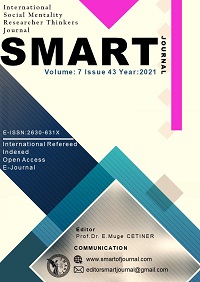INCREASING THE AGRICULTURAL ADDED VALUE IN THE CONTEXT OF THE SUSTAINABLE AGRICULTURAL FOOD VALUE CHAIN: DIGITAL AGRICULTURE
Author :
Abstract
Rapidly increasing world population and the ongoing climate change process raise questions about the sustainability and balancing of demand and supply in the agricultural sector. According to increasing in production technology, the agricultural sector is also affected by these technologies. countries are taking a step towards a sustainable future with the changes in the agricultural food value chain, In this value chain, adaptation to technological changes has a great importance. In this study, in order to ensure continuity of supply and increase efficiency in agricultural production, the importance of Agriculture 4.0 applications for Turkey is mentioned and provides a detailed evaluation of technology diffusion, digitization, innovation, and value-added production in Turkish food and agricultural sectors, presents a descriptive analysis comparing Turkey with the rest of the world, performs statistical analyses that help us better understand the patterns of agricultural value-added production patterns, discusses the results and implications in detail, and, accordingly, recommends various policies.
Keywords
Abstract
Rapidly increasing world population and the ongoing climate change process raise questions about the sustainability and balancing of demand and supply in the agricultural sector. According to increasing in production technology, the agricultural sector is also affected by these technologies. countries are taking a step towards a sustainable future with the changes in the agricultural food value chain, In this value chain, adaptation to technological changes has a great importance. In this study, in order to ensure continuity of supply and increase efficiency in agricultural production, the importance of Agriculture 4.0 applications for Turkey is mentioned and provides a detailed evaluation of technology diffusion, digitization, innovation, and value-added production in Turkish food and agricultural sectors, presents a descriptive analysis comparing Turkey with the rest of the world, performs statistical analyses that help us better understand the patterns of agricultural value-added production patterns, discusses the results and implications in detail, and, accordingly, recommends various policies.
Keywords
- Adanacıoğlu, H. Saner, G. Ağır, B. (2018). Sürdürülebilir Gıda Değer Zinciri Yaklaşımı. KSÜ Tarım ve
- Adanacıoğlu, H. Saner, G. Ağır, B. (2018). Sürdürülebilir Gıda Değer Zinciri Yaklaşımı. KSÜ Tarım ve Doğa Dergisi 21(Özel Sayı): 221-226.
- Aşarkaya, A. (2015). Tarım Sektörü Raporu. Türkiye İş Bankası İktisadi Araştırmalar Bölümü.
- Bresnyan E. & Werbrouck P. (2012). Value chains and small farmer integration. Latin America andCaribbean agriculture for development brief. Washington, DC: World Bank. http://documents.worldbank.org/curated/ en/489001468270654669/ Erişim Tarihi: 23.12.2016
- Burrell, A. and Kurzweil, M. (2007). Distortions to agricultural incentives in Turkey: Main report. Agricultural Distortions working paper, No. 10. Washington, DC: World Bank.
- Doğan, Z., Arslan, S., & Berkman, A. N. (2015). Türkiye’de Tarım Sektörünün İktisadi Gelişimi ve Sorunları: Tarihsel Bir Bakış. Niğde Üniversitesi İktisadi ve İdari Bilimler Fakültesi Dergisi, 30.
- FAO 2018. Sustainable Food Value Chains Knowledge Platform. http://www.fao.org/sustainable-food-value -chains/what-is-it/en/. (Erişim tarihi: 27.12.2020).
- Fitter, R. (2001). Who Gains from Product Rents as the Coffee Market Becomes More Differentiated? A Value chain Analysis.” IDS bulletin 32/.3, p. 69-82.
- Jouanjean, M. (2019), “Digital Opportunities for Trade in the Agriculture and Food Sectors,” OECD Food, Agriculture and Fisheries Papers, No. 122.
- Kaplinsky, R., & Morris, M. (2001). A handbook for value chain research (Vol. 113). Ottawa: IDRC.
- Kelly, S., Bensemann, J., Bhıda, V., Eweje, G., Scott, J., Lockhart, J., Taskın, N., Warren, L. (2017),“Disruptive Technology in the Agri-food Sector: An Examination of Current and Future Influence on Sustainability, Bio-Security, and Business Effectiveness,” Massey University, New Zealand
- Kılavuz, E. ve Erdem, İ., (2019). Dünyada Tarım 4.0 Uygulamaları ve Türk Tarımının Dönüşümü, Social Sciences (NWSASOS), 14(4):133-157, DOI:10.12739/NWSA.2019.14.4.3C0189.
- Kirmikil, M. Ertaş, B. (2020). Tarım 4,0 ile Sürdürülebilir Bir Gelecek. Icontech International Journal Of Surveys, Engineering,Technology.
- Muchopa, Chiedza L. (2013). Agricultural Value chains and Smallholder Producer Relations in The contextof Supermarket Chain Proliferation in Southern Africa, International Journal of Managing Value and Supply Chains (IJMVSC) Vol.4, No. 3, September, DOI: 10.5121/ ijmvsc.2013.4304 33
- MÜSİAD (2010). Türkiye’nin Tarımsal Gücü ve Geleceği.
- Neven, D. (2014). Developing sustainable food value chains - Guiding Principles, Food and Agriculture Organization of the United Nations, Rome.
- OECD (2011). Evaluation of Agricultural Policy Reforms in Turkey, OECD Publishing. http://dx.doi.org/10.1787/9789264113220-en (Erişim tarihi: 27.12.2020).
- Pesce M., Kırova M., Soma K., Bogaardt, M.-J., Poppe, K., Thurston, C., Monfort Belles, C., Wolfert, S.,Beers, G., Urdu, D. (2019), “Research for AGRI Committee – Impacts of the digital economy on the food-
- chain and the CAP,” European Parliament, Policy Department for Structural and Cohesion Policies, Brussels.OECD (2016). Agricultural Policy Monitoring and Evaluation 2016. http://www.keepeek.com/Digital-Asset-Management/oecd/agriculture-and-food/agricultural-policy -monitoring-and-evaluation-2016_agr_pol- 2016-en#page126 (Erişim tarihi: 27.12.2020).
- TIM (2016). Türkiye İhracatçılar Meclisi: Tarım Raporu. TOBB (2013). Türkı̇ye Tarım Sektörü Raporu.
- Tümen, S. Özertan, G. (2020). Katma Değerin Artırılması, İnovasyon Ve Dijital Tarım. TUSİAD 2020 Tarım Raporu. Yayın No: TÜSİAD-T/2020-03/615. Ankara.
- TÜSİAD (2016). Yapısal Sorunlar Perspektifinden Gıda Enflasyonu. TÜSİAD, 09-578.
- TC. Cumhurbaşkanlığı Strateji ve Bütçe Başkanlığı (2019). On_Bırıncı_Kalkınma-Planı_2019-2023.pdf (sbb.gov.tr)
- T.C. Kalkınma Bakanlığı (2014). Uluslararası Ekonomik Göstergeler
- Verbeek, A., Fackelmann, S., Mcdonagh, B. (2019), “Feeding future generations: How finance can boost innovation in agri-food,” European Investment Bank.
- 2016 Süt Raporu. (2019). (s. 56). İstanbul: Ulusal Süt Konseyi.
